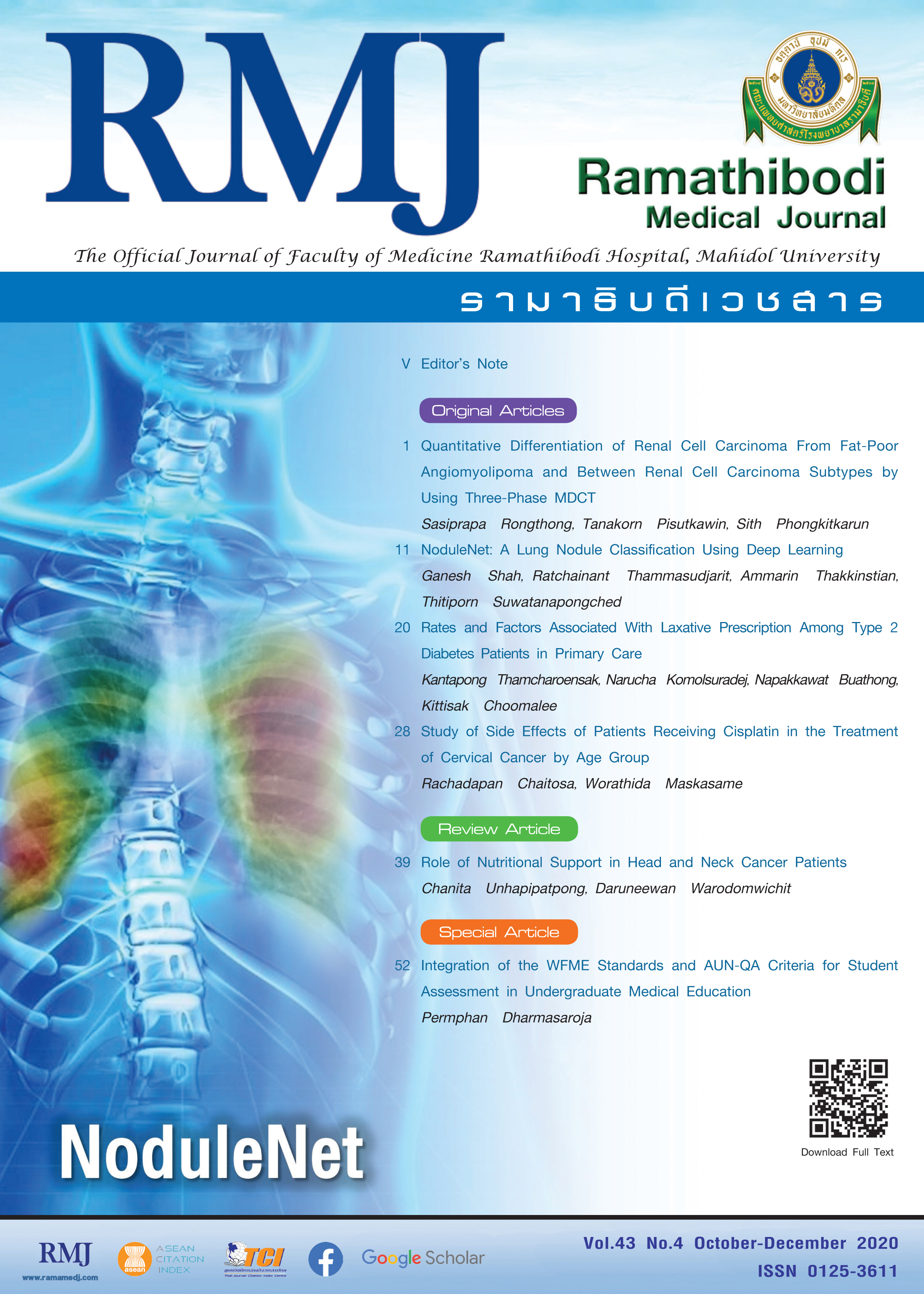Quantitative Differentiation of Renal Cell Carcinoma From Fat-Poor Angiomyolipoma and Between Renal Cell Carcinoma Subtypes by Using Three-Phase MDCT
DOI:
https://doi.org/10.33165/rmj.2020.43.4.243934Keywords:
Renal cell carcinoma, Angiomyolipoma, Fat-poor angiomyolipoma, MDCTAbstract
Background: Renal cell carcinoma (RCC) can be differentiated from angiomyolipoma by detection of macroscopic fat at multidetector computed tomography (MDCT). Measurement of enhancement at MDCT help classifying between RCC subtypes, which possibly predict tumor prognosis.
Objective: Retrospectively assess whether quantitative measurements (percentage enhancement ratio [PER] and absolute washout ratio [AWR]) of renal mass enhancement during three-phase MDCT help differentiating RCC from fat-poor angiomyolipoma and other RCC subtypes.
Methods: The retrospective review of the preoperative three-phase MDCT (unenhanced, corticomedullary, and early excretory phases) performed between January 2008 and July 2017, a total of 75 renal lesions (74 consecutive patients) were assessed for attenuation values in each phase. The enhancement values (PER and AWR) were compared by ANOVA tests. Cutoff analysis of enhancement values was performed to determine optimal threshold for each histologic subtype.
Results: The attenuation value of fat-poor angiomyolipoma was significantly higher than clear cell RCCs in unenhanced phase (P = .02). The PER of the clear cell RCCs was significantly lower than that of papillary RCCs, chromophobe RCCs, and fat-poor angiomyolipomas (P < .001). The AWR of the clear cell RCCs showed significantly greater than that of papillary RCCs and fat-poor angiomyolipoma (P < .001). The PER and AWR thresholds for differentiating RCCs from fat-poor angiomyolipoma were 93.0 and 31.6 with accuracy of 74.7% and 77.3%, respectively.
Conclusions: Quantitative measurement of enhancement (PER and AWR) might help differentiating RCCs from fat-poor angiomyolipoma, and differentiating clear cell RCCs from papillary RCCs.
References
Siegel R, Naishadham D, Jemal A. Cancer statistics, 2012. CA Cancer J Clin. 2012;62(1):10-29. doi:10.3322/caac.20138.
Information and Technology Division of National Cancer Institute. Hospital-Based Cancer Registry Annual Report 2010. Bangkok: National Cancer Institute, Department of Medical Service, Ministry of Public Health; 2011:23. http://www.nci.go.th/th/File_download/Nci%20Cancer%20Registry/Hospital%20Based%20Cancer%20Registry2010.pdf. Accessed August 7, 2020.
Information and Technology Division of National Cancer Institute. Hospital-Based Cancer Registry Annual Report 2011. Bangkok: National Cancer Institute, Department of Medical Service, Ministry of Public Health; 2012:34. http://www.nci.go.th/th/File_download/Nci%20Cancer%20Registry/Hospitalbase2011.pdf. Accessed August 7, 2020.
Information and Technology Division of National Cancer Institute. Hospital-Based Cancer Registry Annual Report 2012. Bangkok: National Cancer Institute, Department of Medical Service, Ministry of Public Health; 2014:25. http://www.nci.go.th/th/File_download/Nci%20Cancer%20Registry/Hospital-Based%20NCI%202012%20Total.pdf. Accessed August 7, 2020.
Information and Technology Division of National Cancer Institute. Hospital-Based Cancer Registry Annual Report 2013. Bangkok: National Cancer Institute, Department of Medical Service, Ministry of Public Health; 2015:24. http://www.nci.go.th/th/File_download/Nci%20Cancer%20Registry/HOSPITAL-BASED%202013.pdf. Accessed August 7, 2020.
Information and Technology Division of National Cancer Institute. Hospital-Based Cancer Registry Annual Report 2014. Bangkok: National Cancer Institute, Department of Medical Service, Ministry of Public Health; 2016:35. http://www.nci.go.th/th/File_download/Nci%20Cancer%20Registry/HOSPITAL-BASED%202014.pdf. Accessed August 7, 2020.
Reuter VE. The pathology of renal epithelial neoplasms. Semin Oncol. 2006;33(5):534-543. doi:10.1053/j.seminoncol.2006.06.009.
Kovacs G, Akhtar M, Beckwith BJ, et al. The Heidelberg classification of renal cell tumours. J Pathol. 1997;183(2):131-133. doi:10.1002/(SICI)1096-9896(199710)183:2<131::AID-PATH931>3.0.CO;2-G.
Truong LD, Shen SS. Immunohistochemical diagnosis of renal neoplasms. Arch Pathol Lab Med. 2011;135(1):92-109. doi:10.1043/2010-0478-RAR.1.
Bostwick DG, Eble JN. Diagnosis and classification of renal cell carcinoma. Urol Clin North Am. 1999;26(3):627-635. doi:10.1016/s0094-0143(05)70203-2.
Kim JK, Kim TK, Ahn HJ, Kim CS, Kim KR, Cho KS. Differentiation of subtypes of renal cell carcinoma on helical CT scans. AJR Am J Roentgenol. 2002;178(6):1499-1506. doi:10.2214/ajr.178.6.1781499.
Simpson E, Patel U. Diagnosis of angiomyolipoma using computed tomography-region of interest < or =-10 HU or 4 adjacent pixels < or =-10 HU are recommended as the diagnostic thresholds. Clin Radiol. 2006;61(5):410-416. doi:10.1016/j.crad.2005.12.013.
Hafron J, Fogarty JD, Hoenig DM, Li M, Berkenblit R, Ghavamian R. Imaging characteristics of minimal fat renal angiomyolipoma with histologic correlations. Urology. 2005;66(6):1155-1159. doi:10.1016/j.urology.2005.06.119.
Hollingsworth JM, Miller DC, Daignault S, Hollenbeck BK. Rising incidence of small renal masses: a need to reassess treatment effect. J Natl Cancer Inst. 2006;98(18):1331-1334. doi:10.1093/jnci/djj362.
Rothman J, Egleston B, Wong YN, Iffrig K, Lebovitch S, Uzzo RG. Histopathological characteristics of localized renal cell carcinoma correlate with tumor size: a SEER analysis. J Urol. 2009;181(1):29-34. doi:10.1016/j.juro.2008.09.009.
Thompson RH, Kurta JM, Kaag M, et al. Tumor size is associated with malignant potential in renal cell carcinoma cases. J Urol. 2009;181(5):2033-2036. doi:10.1016/j.juro.2009.01.027.
Kim JK, Park SY, Shon JH, Cho KS. Angiomyolipoma with minimal fat: differentiation from renal cell carcinoma at biphasic helical CT. Radiology. 2004;230(3):677-684. doi:10.1148/radiol.2303030003.
Jinzaki M, Tanimoto A, Narimatsu Y, et al. Angiomyolipoma: imaging findings in lesions with minimal fat. Radiology. 1997;205(2):497-502. doi:10.1148/radiology.205.2.9356635.
Zhang J, Lefkowitz RA, Ishill NM, et al. Solid renal cortical tumors: differentiation with CT. Radiology. 2007;244(2):494-504. doi:10.1148/radiol.2442060927.
Xie P, Yang Z, Yuan Z. Lipid-poor renal angiomyolipoma: differentiation from clear cell renal cell carcinoma using wash-in and washout characteristics on contrast-enhanced computed tomography. Oncol Lett. 2016;11(3):2327-2331. doi:10.3892/ol.2016.4214.
Johnson PT, Horton KM, Fishman EK. Adrenal mass imaging with multidetector CT: pathologic conditions, pearls, and pitfalls. Radiographics. 2009;29(5):1333-1351. doi:10.1148/rg.295095027.
Kim SH, Kim CS, Kim MJ, Cho JY, Cho SH. Differentiation of clear cell renal cell carcinoma from other subtypes and fat-poor angiomyolipoma by use of quantitative enhancement measurement during three-phase MDCT. AJR Am J Roentgenol. 2016;206(1):W21-W28. doi:10.2214/AJR.15.14666.
Lee-Felker SA, Felker ER, Tan N, et al. Qualitative and quantitative MDCT features for differentiating clear cell renal cell carcinoma from other solid renal cortical masses. AJR Am J Roentgenol. 2014;203(5):W516-W524. doi:10.2214/AJR.14.12460.

















